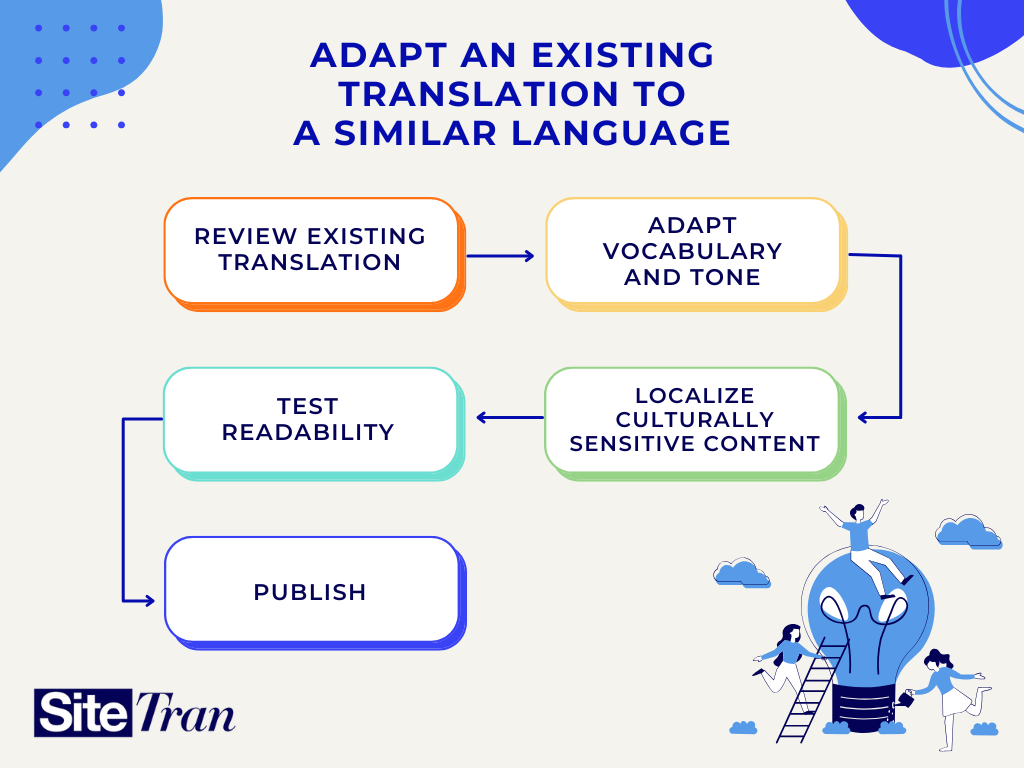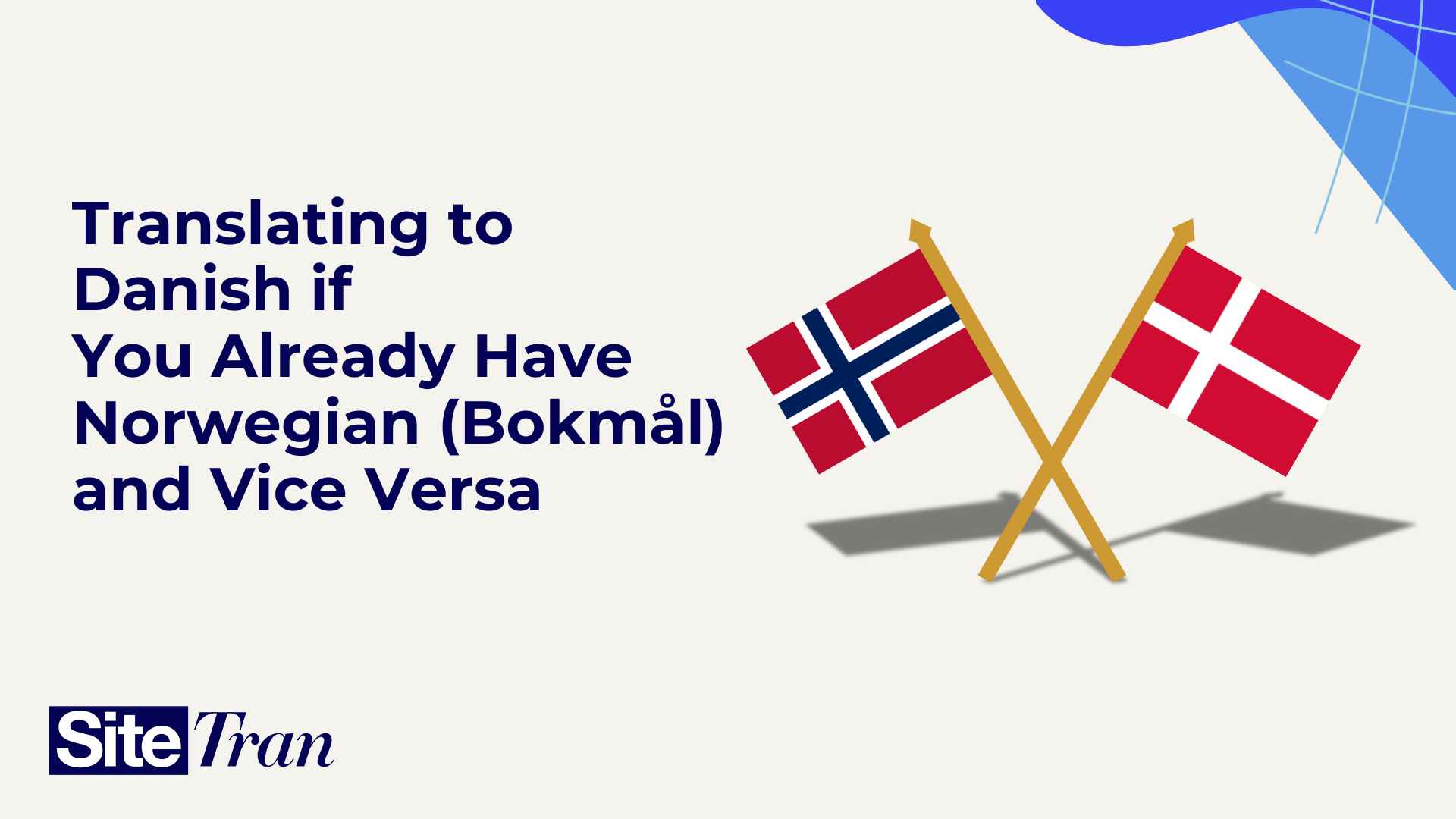Introduction: Reaching Both Danish and Norwegian Audiences
Expanding a business into the Scandinavian market offers unique opportunities, particularly because Norwegian (Bokmål) and Danish share a great deal of linguistic overlap. If you already have a Norwegian Bokmål translation, it’s tempting to think that creating a Danish version will be a breeze. But while the two languages are close enough for general mutual understanding, they’re not identical—especially in written form.
This post will explore the process of adapting content between Bokmål Norwegian and Danish and explain when and how translation shortcuts might work, saving time and money. By using a translation tool like SiteTran, you can simplify the process of reaching both Norwegian and Danish audiences while ensuring accuracy and cultural relevance.
1. Understanding the Similarities and Differences Between Norwegian (Bokmål) and Danish
Mutual Intelligibility
Norwegian Bokmål and Danish are highly mutually intelligible in writing, with vocabulary and grammar that overlap significantly due to shared historical roots. In many cases, a Norwegian Bokmål reader can understand a Danish text without substantial difficulty, and vice versa. This closeness is often due to a shared history, with both languages influenced by Old Norse and centuries of contact.
Pronunciation and Formality
While written forms are closely aligned, spoken Norwegian Bokmål and Danish sound quite different. Danish pronunciation can be more challenging for Norwegian speakers and vice versa due to phonetic variances. Additionally, Danish tends to have a slightly more formal tone in certain expressions, which can impact translation choices. The good news is that when it comes to text-based translation, this won’t be an issue!
Spelling and Vocabulary Variations
There are notable spelling differences, even if the words share the same meaning. For example:
- Butter is smør in both languages, but the pronunciation differs.
- Language is språk in Norwegian, while in Danish, it’s sprog. While this difference is minor, it’s one of many small adjustments that should be made for an accurate adaptation.
Direction for Websites
While written Norwegian and Danish are both left-to-right, the spelling variations mean that if you’re translating content for a website, you’ll still need to adjust the text specifically for each audience. Simply copying and pasting isn’t enough, as readers will expect the text to be tailored to their language norms. That said, a translator familiar with both languages can often adapt a significant portion of the text, avoiding a full rewrite.
2. Translation Shortcuts: Can You Leverage Existing Translations?
Given these similarities, is it possible to leverage existing translations to create content for the other language? The answer is often yes, especially for non-creative or technical content.
For technical or informational content, such as product descriptions, user manuals, or help documentation, a Bokmål Norwegian translation can often serve as a foundation for Danish. A translator can make minor adjustments to spelling and vocabulary to make it flow naturally for Danish readers. This approach is cost-effective and efficient, as it avoids duplicating effort while still respecting linguistic differences.
For marketing and brand-oriented content, however, a more tailored approach is often required. A phrase or slogan that feels friendly and casual in Norwegian Bokmål may not convey the same tone in Danish, which tends to be more formal. Additionally, small cultural references may need tweaking to resonate with Danish readers. For example:
A Norwegian travel brand might emphasize Norway’s famous fjords in Norwegian content, but for Danish content, it might highlight city life or historical landmarks to connect better with Danish interests.
3. Cost-Benefit Analysis: When to Invest in Separate Translations
Determining whether to adapt or fully translate content depends on its purpose. Here’s a breakdown of scenarios:
General Information or Technical Content
For content that focuses on factual information or straightforward descriptions, an adapted translation is usually adequate. A product manual, FAQ, or technical guide can often be localized with minor changes. A professional translator can make adjustments to spelling, grammar, and tone, producing content that feels native to each audience without duplicating the effort.
Marketing, Cultural, or Conversational Content
For anything brand-oriented or audience-facing, like ad copy, About Us pages, or promotional campaigns, a unique translation will often serve you better. By investing in distinct versions, you ensure that your brand’s voice aligns with the slightly different cultural expectations of Norwegian and Danish audiences.
Example Scenario: Suppose you run an e-commerce website that serves Norway and Denmark. Your product descriptions can likely be adapted from Norwegian Bokmål to Danish with minor adjustments. However, your homepage or “About Us” page, which conveys your brand’s story and mission, would benefit from dedicated translations. This allows you to account for the slightly more formal tone preferred by Danish audiences, providing a smoother and more authentic user experience.
Tip: Adapt, Don’t Just Translate! Ensure that each translation feels natural to native readers. Even small changes in phrasing or tone can enhance readability and user experience.

4. Streamline Your Process with a Website Translation Tool Like SiteTran
To manage translations efficiently, a tool like SiteTran can help streamline the adaptation process. Rather than managing two separate documents or coordinating translations by email, SiteTran’s centralized platform makes it easy to adapt content from one language to another, track changes, and collaborate with translators in real time. Here’s how it works:
- Efficient Management and Communication: SiteTran’s dashboard allows you to keep all translations organized, communicate seamlessly with translators, and ensure consistency across projects. This is especially useful for businesses handling similar languages, where slight modifications are often the key to adaptation.
- Glossary for Consistency: SiteTran’s glossary feature ensures that key terms remain consistent between Norwegian and Danish, particularly for brand-specific terminology or technical jargon.
- AI-Powered Translation Suggestions: SiteTran provides AI-generated translation suggestions, which give translators a head start. For similar languages like Norwegian and Danish, these suggestions can save time by proposing common vocabulary and phrasing, which translators can then refine.
- Translation History: SiteTran’s history feature allows you to look back at past translations, ensuring that you maintain continuity in style and phrasing even as you expand or update content.
With SiteTran, you can leverage shared linguistic features between Norwegian and Danish, making the adaptation process faster and more affordable without sacrificing quality.
Conclusion: Make the Most of Norwegian and Danish Translations
Expanding into Norwegian and Danish markets is a smart move, as their similarities offer unique efficiency opportunities for businesses. While these languages are close enough for efficient adaptation, the differences in tone, spelling, and cultural preferences mean that a direct copy won’t always be effective.
Using a translation tool like SiteTran simplifies this process, allowing you to manage and adapt content efficiently while retaining quality. With SiteTran’s features, you can oversee and adjust translations with ease, making your content resonate with both audiences without duplicating effort.
By approaching Norwegian Bokmål and Danish translation strategically, you’ll be able to provide a smooth, native experience for readers across both languages, expanding your reach in the Scandinavian market.

